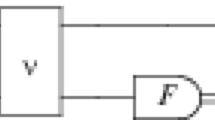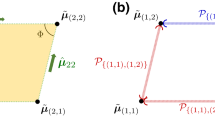Abstract
Quantum-state tomography (QST) is a fundamental task for reconstructing unknown quantum state from statistics of measurements. We propose a qudit-state tomography based on unambiguous discrimination (UD) of d linearly independent pure states. We then prove that our proposal for QST provides a minimal set of measurements. Our proposal can be used in any finite dimension, and our strategy can be realized by a projective measurement on a system combined with a d-dimensional auxiliary system. In addition, we present another method to improve previously known UD QST of pure quantum state.



Similar content being viewed by others
Explore related subjects
Discover the latest articles, news and stories from top researchers in related subjects.References
Stokes, G.C.: On the composition and resolution of streams of polarized light from different sources. Trans. Camb. Philos. Soc. 9, 399 (1852)
Peres, A.: Quantum Theory: Concepts and Methods. Kluwer, Amsterdam (1995)
James, D.F.V., Kwiat, P.G., Munro, W.J., White, A.G.: Measurement of qubits. Phys. Rev. A 64, 052312 (2001)
Thew, R.T., Nemoto, K., White, A.G., Munro, W.J.: Qudit quantum-state tomography. Phys. Rev. A 66, 012303 (2002)
Leonhardt, U.: Measuring the Quantum State of Light. Cambridge University Press, Cambridge (2005)
Paris, M., Řeháček, J.: Quantum State Estimation. Springer, Berlin (2004)
Ivanović, I.D.: Geometrical description of quantal state determination. J. Phys. A Math. Gen. 14, 3241 (1981)
Wootters, W.K., Fields, B.D.: Optimal state-determination by mutually unbiased measurements. Ann. Phys. 191, 363 (1989)
Bandyopadhyay, S., Boykin, P.O., Roychowdhury, V., Vatan, F.: A new proof for the existence of mutually unbiased bases. Algorithmica 34, 512 (2002)
Prugovečki, E.: Information-theoretical aspects of quantum measurement. Int. J. Theor. Phys. 16, 321 (1977)
Caves, C.M., Fuchs, C.A., Schack, R.: Unknown quantum states: the quantum de Finetti representation. J. Math. Phys. 43, 4537 (2002)
Lemmens, P.W.H., Seidel, J.J.: Equiangular lines. J. Alegebra 24, 494 (1973)
Renes, J.M., Blume-Kohout, R., Scott, A.J., Caves, C.M.: Symmetric informationally complete quantum measurements. J. Math. Phys. 45, 2171 (2004)
Scott, A.J., Grassl, M.: Symmetric informationally complete positive-operator-valued measures: a new computer study. J. Math. Phys. 51, 042203 (2010)
Gour, G., Kalev, A.: Construction of all general symmetric informationally complete measurements. J. Phys. A Math. Theor. 47, 335302 (2014)
Kalev, A., Gour, G.: Mutually unbiased measurements in finite dimensions. New J. Phys. 16, 053038 (2014)
Salazar, R., Delgado, A.: Quantum tomography via unambiguous state discrimination. Phys. Rev. A 86, 012118 (2012)
Ivanovic, I.D.: How to differentiate between non-orthogonal states. Phys. Lett. A 123, 257 (1987)
Dieks, D.: Overlap and distinguishability of quantum states. Phys. Lett. A 126, 303 (1988)
Peres, A.: How to differentiate between non-orthogonal states. Phys. Lett. A 128, 19 (1988)
Jaeger, G., Shimony, A.: Optimal distinction between two non-orthogonal quantum states. Phys. Lett. A 197, 83 (1995)
Chefles, A.: Unambiguous discrimination between linearly independent quantum states. Phys. Lett. A 239, 339 (1998)
Rudolph, T., Spekkens, R.W., Turner, P.S.: Unambiguous discrimination of mixed states. Phys. Rev. A 68, 010301(R) (2003)
Herzog, U., Bergou, J.A.: Optimum unambiguous discrimination of two mixed quantum states. Phys. Rev. A 71, 050301(R) (2005)
Pang, S., Wu, S.: Optimum unambiguous discrimination of linearly independent pure states. Phys. Rev. A 80, 052320 (2009)
Kleinmann, M., Kampermann, H., Bruß, D.: Structural approach to unambiguous discrimination of two mixed quantum states. J. Math. Phys. 51, 032201 (2010)
Sugimoto, H., Hashimoto, T., Horibe, M., Hayashi, A.: Complete solution for unambiguous discrimination of three pure states with real inner products. Phys. Rev. A 82, 032338 (2010)
Bergou, J.A., Futschik, U., Feldman, E.: Optimal Unambiguous Discrimination of Pure Quantum States. Phys. Rev. Lett. 108, 250502 (2012)
Ha, D., Kwon, Y.: Analysis of optimal unambiguous discrimination of three pure quantum states. Phys. Rev. A 91, 062312 (2015)
Adams, W.W., Goldstein, L.J.: Introduction to Number Theory. Prentice-Hall, Englewood Cliffs (1976)
Nielsen, M.A., Chuang, I.L.: Quantum Computation and Quantum Information. Cambridge University Press, New York (2010)
Baumgratz, T., Cramer, M., Plenio, M.B.: Quantifying coherence. Phys. Rev. Lett. 113, 140401 (2014)
Finkelstein, J.: Pure-state informationally complete and “really” complete measurements. Phys. Rev. A 70, 052107 (2004)
Acknowledgements
This work is supported by the Basic Science Research Program through the National Research Foundation of Korea funded by the Ministry of Education, Science and Technology (NRF2015R1D1A1A01060795).
Author information
Authors and Affiliations
Corresponding author
Appendices
A Proof of Lemma 1
Proof
Let r be an integer in \(\mathbb {Z}_{g}\). Then we have \(|\mathbb {Z}_{d}^{m,r}|\le n\) because \(nm+r\equiv r(\mathrm{mod}\ d)\). If two integers \(k_{1},k_{2}\in \mathbb {Z}_{n}\) satisfy \(k_{1}<k_{2}\) and \(k_{1}m+r\equiv k_{2}m+r(\mathrm{mod}\ d)\), \(k_{2}-k_{1}\) should be a multiple of n because \((k_{2}-k_{1})m \equiv 0(\mathrm{mod}\ d)\). However, this is a contradiction since \(0<k_{2}-k_{1}<n\). Therefore, we have \(|\mathbb {Z}_{d}^{m,r}|=n\) and \(\mathbb {Z}_{d}^{m,r}=\{z_{d,k}^{m,r}\}_{k\in \mathbb {Z}_{n}}\).
Let \(r_{1},r_{2}\in \mathbb {Z}_{g}\) be two integers satisfying \( r_{1}<r_{2}\). Then we get \(\mathbb {Z}_{d}^{m,r_{1}}\cap \mathbb {Z}_{d}^{m,r_{2}}=\emptyset \) because if it is a non-empty set, we have \(k_{1}m+r_{1}\equiv k_{2}m+r_{2}(\mathrm{mod}\ d)\) for some different integers \(k_{1}\),\(k_{2}\). This implies \((k_{1}-k_{2})m\equiv r_{2}-r_{1}(\mathrm{mod}\ d)\), which induces the following contradiction
This means \(|\bigcup _{r\in \mathbb {Z}_{g}}\mathbb {Z}_{d}^{m,r}|=g\times n=d\) by \(|\mathbb {Z}_{d}^{m,r}|=n\). Therefore, we have \(\bigcup _{r\in \mathbb {Z}_{g}}\mathbb {Z}_{d}^{m,r}=\mathbb {Z}_{d}\) by \(|\mathbb {Z}_{d}|=d\).\(\square \)
B Derivation of Eq. (14)
Proof
Since \(d-n\) pure states \(|\psi _{i}\rangle \) except n pure states \(|\psi _{x_{k}}\rangle \) are comprised by \(d-n\) pure states \(|e_{i}\rangle \) without n pure states \(|e_{x_{k}}\rangle \), the following relation holds.
where
By \(|e_{x_{k}}\rangle \) of (13), the right-hand side of the above equation can be expressed as follows.
where
Therefore, \(\tilde{\rho }_{x_{k+1}x_{k+1}}\) becomes \((a_{kk}-b_{kk})/(1-\cos n\phi )\). \(\square \)
C Derivation of Eq. (23)
Proof
Since \(d-2\) pure states \(|\psi _{i}\rangle \) excluding two pure states \(|\psi _{x}\rangle \),\(|\psi _{y}\rangle \) are comprised by \(d-2\) pure states \(|e_{i}\rangle \) except two pure states \(|e_{x}\rangle \),\(|e_{y}\rangle \), the following relation holds:
where
Using (22), \(|e_{x}\rangle \) and \(|e_{y}\rangle \) are expressed by \(|\psi _{x}\rangle ,|\psi _{y}\rangle \) as follows:
Then, by (42) the right-hand side of (40) is expressed as follows.
The above equation provides (23). \(\square \)
Rights and permissions
About this article
Cite this article
Ha, D., Kwon, Y. A minimal set of measurements for qudit-state tomography based on unambiguous discrimination. Quantum Inf Process 17, 232 (2018). https://doi.org/10.1007/s11128-018-1997-4
Received:
Accepted:
Published:
DOI: https://doi.org/10.1007/s11128-018-1997-4




